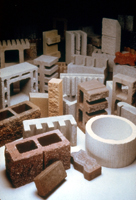 Masonry units are available in sizes, shapes, colors, textures, and profiles for practically every conceivable need. Historically, units came from a variety of sources and included materials such as rock and stone, either natural or cut. Today, units most commonly used are concrete block or clay brick, offering standardized sizes and mechanical properties. The units are joined together by mortars made from a binder consisting of one or more cements for masonry, sand, and water. Portland cement plaster, or stucco, is made from the same material as mortars, and as such, is sometimes considered to be a masonry product as well.
Masonry units are available in sizes, shapes, colors, textures, and profiles for practically every conceivable need. Historically, units came from a variety of sources and included materials such as rock and stone, either natural or cut. Today, units most commonly used are concrete block or clay brick, offering standardized sizes and mechanical properties. The units are joined together by mortars made from a binder consisting of one or more cements for masonry, sand, and water. Portland cement plaster, or stucco, is made from the same material as mortars, and as such, is sometimes considered to be a masonry product as well.
Masonry is widely used to construct small and large structures because of its attractive appearance, minimum maintenance, safety (fire resistance and wind/earthquake resistance), and economy. Masonry provides an effective barrier to sound and reduces internal temperature variations and peak loads on heating and cooling systems. It provides architectural freedom and versatility with striking aesthetic appeal. Almost any shape of structure is possible.
When high winds occur, reinforced masonry buildings resist the pressures and flying debris that can knock down or damage less robust construction. Masonry can offer fire resistant qualities that saves homes.
Masonry also resists weathering and vandalism. The durability and minimum maintenance extend a building’s useful life, providing an enduring, high-quality appearance.
Masonry Products
Modern masonry products include portland cement plaster (stucco), cements for masonry, mortars, concrete block, and clay brick. These materials can be used on the interior or exterior of structures in a wide range of environments. Load-bearing walls serve a structural purpose, while veneers and claddings, frequently used as architectural finishes, also function as weather barriers. Whichever materials are used, modern masonry construction provides durability, safety, aesthetic appeal, and other benefits in a cost-effective manner.
Brick
Brick is the oldest manufactured building material. The earliest brick, made from mud (sometimes with added straw), was invented almost 10,000 years ago. Clay brick started to appear about 5,000 years ago, when builders borrowed pottery manufacturing techniques to improve its strength and durability. From some of the oldest known structures to modern buildings, clay brick has a history of providing shelter that is durable, comfortable, safe, and attractive.
Cements for Masonry
Cements for masonry include masonry cement (ASTM C 91) and mortar cement (ASTM C 1329). They are hydraulic cements designed for use in mortar for masonry construction. Masonry cement consists of a mixture of portland cement or blended hydraulic cement and plasticizing materials (such as limestone or hydrated or hydraulic lime), together with other materials introduced to enhance one or more properties such as setting time, workability, water retention and durability. These components are proportioned at the cement plant under controlled conditions to assure uniformity of performance.
Concrete Masonry Units
Since 1882, when the first concrete block was molded,
concrete masonry units have become a standard building material. Concrete blocks create structures that are economical, energy efficient, fire-resistant, and involve minimal maintenance. In addition, concrete masonry allows architectural freedom and versatility.
Mortar & Grout
Masonry mortar is composed of one or more cementitious materials, clean well-graded masonry sand, and sufficient water to produce a plastic, workable mixture. Grout for masonry is composed of similar materials, but is generally mixed to a much more fluid condition. It may also contain coarse aggregate.
Stucco
Stucco, the common term for portland cement plaster, is a popular exterior finish for buildings. It provides an economical hard surface that is rot, rust, and fire resistant, which can be colored and finished in a wide range of textures to adorn any architectural style.